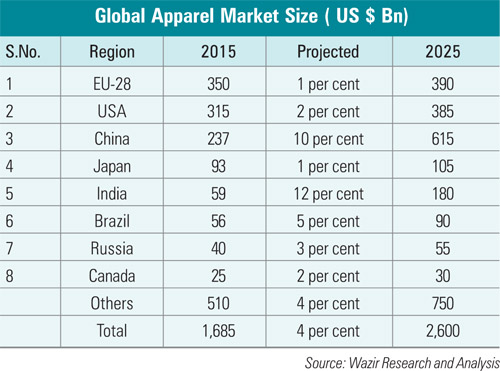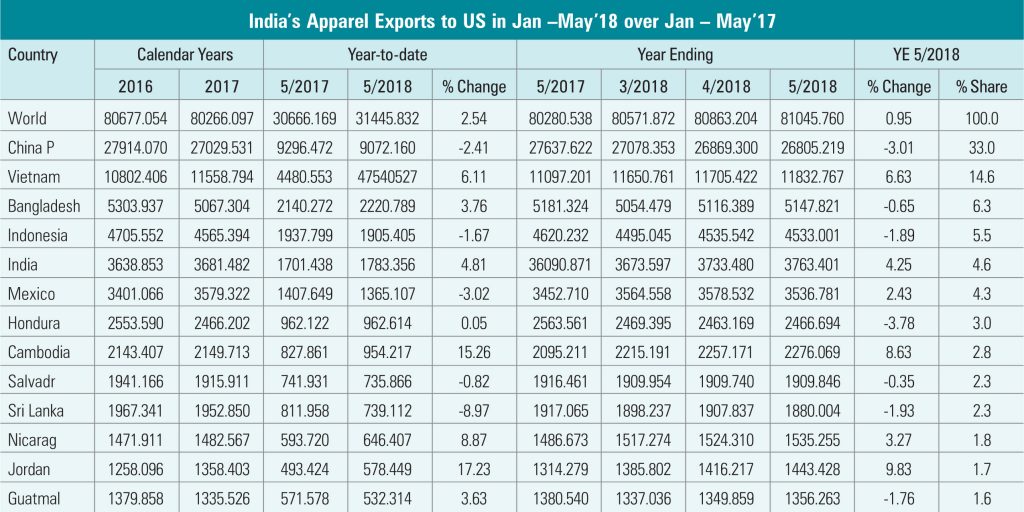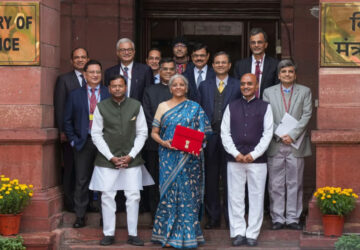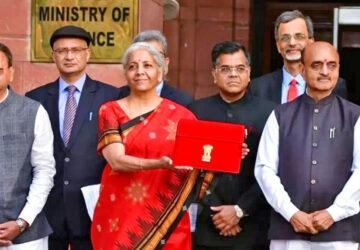With India facing several odds can we expect its textiles and apparel exports to do better in the US market? If statistics is to be believed, apparel exports have posted a healthy growth in the first five months of 2018 (January-May) over the same period last year. Apparel is the most important item in the country’s export basket. What is more, India has even overtaken China on the export front during the same period. A further encouraging development is that India’s apparel exports have been higher than the total exports of this product by all countries to the US. So, the performance is rather creditable, aided by the economic recovery in the US.
India is facing headwinds by way of a sharp slide in its currency vis-à-vis the US dollar, rising global oil prices, and interest rate in the US and a nonetoo- encouraging current account deficit at home. Currently, India’s share of textile and apparel exports in the US is around 18 per cent. The data shows that India’s apparel exports registered a 4.81 per cent growth, from $1,701 mn to $1,783 mn during the period under review. On the other hand, China’s exports declined by 2.41 per cent to $9,072 mn from $9,296 mn. Vietnam, with a better infrastructure, recorded a 6.11 per cent growth, from $4,480 mn to $4,759 mn.
It also is to be noted that based on the data, India’s apparel exports are more than those of Mexico, Honduras both of which are covered by North American Free Trade Agreement (NAFTA) and Caribbean Basin Initiative (CBI) where their apparel exports qualify for duty-free entry in the US market. Earlier, they had been enjoying quotafree status which was terminated in 2005 after the expiry of the WTO Agreement on Textiles and clothing (ATC). Other Latin American countries like EL Salvador, Costa Rica and Dominican Republic are also covered by agreements of this nature and enjoy duty free entry of apparel in the US.
The data show that exports from Mexico were down by 3.02 per cent, those of Honduras by 0.05 per cent and those of EL Salvador by 0.82 per cent. All these agreements are not without a rider. The countries in question have necessarily to use US fabrics, convert them into garments and export to the US. In effect, this means, there is no manufacturing activity in the US.
As regards non-apparel, which consists of yarn, fabrics and made-ups, China’s exports were at 14.71 per cent compared to India’s 0.26 per cent. Vietnam’s exports notched up a 39.76 per cent growth. In respect of total textiles and apparel exports, India registered a mere 2.36 per cent growth. China’s exports were a shade better as it achieved a growth of 2.88 per cent. Vietnam’s exports were at 7.66 per cent and Bangladesh exports at 3.74 per cent. Exports from Mexico, Honduras and EL Salvador were insignificant – at one per cent, 0.01 per cent and 0.20 per cent respectively.
Before the quotas were abolished through ATC by 2004-end, global trade in textiles and clothing had been governed by the Multi-Fibre Arrangement (MFA) from 1774-1994. WTO came into being on January 1, 1995.
It needs no reiteration that the US again is an important destination for India’s textiles and clothing (T&C) exports. India is the third largest supplier of apparel and textiles products to US, after China and Vietnam. India’s exports to the US reached $7 bn in 2014. These exports have grown at 5.5 per cent Compounded Aggregate Growth Rate (CAGR) over the last five years. In the absence of an FTA, India’s T and C exports could at best keep the same rate over the next five years. However, after signing of an FTA, T and C exports will get a duty advantage in the range of 10-32 per cent in various products categories. This will provide a major boost to exports as China’s manufacturing cost has been rising. Therefore, India, with its large and complete value chain, is the only credible alternative.
According to a study by FICCI and Wazir Advisers, India’s FTA with the US will majorly improve its share in US’s apparel imports. From a value of 5-8 per cent, it could increase as high as 20 per cent by 2025. India’s share in US’s imports of textiles will also increase substantially in segments of MMF yarns and fabrics.
 The current global apparel market is worth $1.7 tr and it constitutes around two per cent of GDP. EU 28, US and China are the largest apparel markets with a combined share of about 54 per cent. The global apparel market size is expected to touch $2.6 tr in 2025 by a projected rate of 4 per cent. The major growth drivers of the global apparel market will be the developing economics, mainly China and India, both growing in double digits. China will become the biggest apparel market, adding more than $378 bn in market size by 2025.
The current global apparel market is worth $1.7 tr and it constitutes around two per cent of GDP. EU 28, US and China are the largest apparel markets with a combined share of about 54 per cent. The global apparel market size is expected to touch $2.6 tr in 2025 by a projected rate of 4 per cent. The major growth drivers of the global apparel market will be the developing economics, mainly China and India, both growing in double digits. China will become the biggest apparel market, adding more than $378 bn in market size by 2025.
These two countries with a large and growing domestic demand, coupled with spending power of people, will lead to a combined addition of around $500 bn in the global apparel market size by 2025. The combined apparel market size of China and India that is $795 bn is expected to exceed the combined size of the EU and the US, that is $775 bn by 2025.
The global apparel and textiles trade worldwide stood at dollar. 820 bn in 2014, growing at CAGR of 5.6 per cent over the last decade. Apparel categories had a large share of 56 per cent, while the remaining had a share of 44 per cent. Over the next decade the global apparel and textiles worldwide is set to reach $1,600 bn by 2025, growing by a CAGR of 6.3 per cent.
As is known, EU and US are the largest markets for textiles and apparel with a share of 36 per cent and 14 per cent respectively. On the supply side, China is the largest supporter of these products in the world with a dominating share of 40 per cent. It is distantly followed by countries like India, Italy and Germany with an approximate share of 5 per cent in the global textiles and apparel exports. The study further notes that the textiles industry has witnessed a major shift in the last three decades in terms of its production base. Till the 1980s, production of textiles and apparel was centered in the US and the EU. But over a period of time, production of these commodities shifted majorly to Asian Countries. Thus was largely due to an attractive low cost manufacturing advantages in these developing countries. Finding production of textile items becoming unprofitable for manufactures due to rising costs, the US and the EU sought alternative destinations. Asian countries, with availability of abundant and cheap manpower, vast natural resources and favourable economic policies were the most attractive destination for manufacturing textiles products.
The shift has meant maximum gains for China. Following the liberalizations of China’s industrial policy in the 1980s, the country experienced a massive boost to industrialisation and, as a result, became a hub of manufacturing. Over this period, China emerged as the biggest manufacturing base for textiles, worldwide, and has remained the largest exporter of textiles and apparel, maintaining a dominant market share of 40 per cent, since 2000. Other Asian countries such as India, Bangladesh, Indonesia, Pakistan, Cambodia, Vietnam and Thailand also experienced an upsurge in their textiles and manufacturing during this period. Currently, the US and Europe have become largest consumption bases in the world, while manufacturing is concentrated in Asian countries such as China and India (large consumption bases as well) Bangladesh, Vietnam, Sri Lanka, Pakistan etc.




















